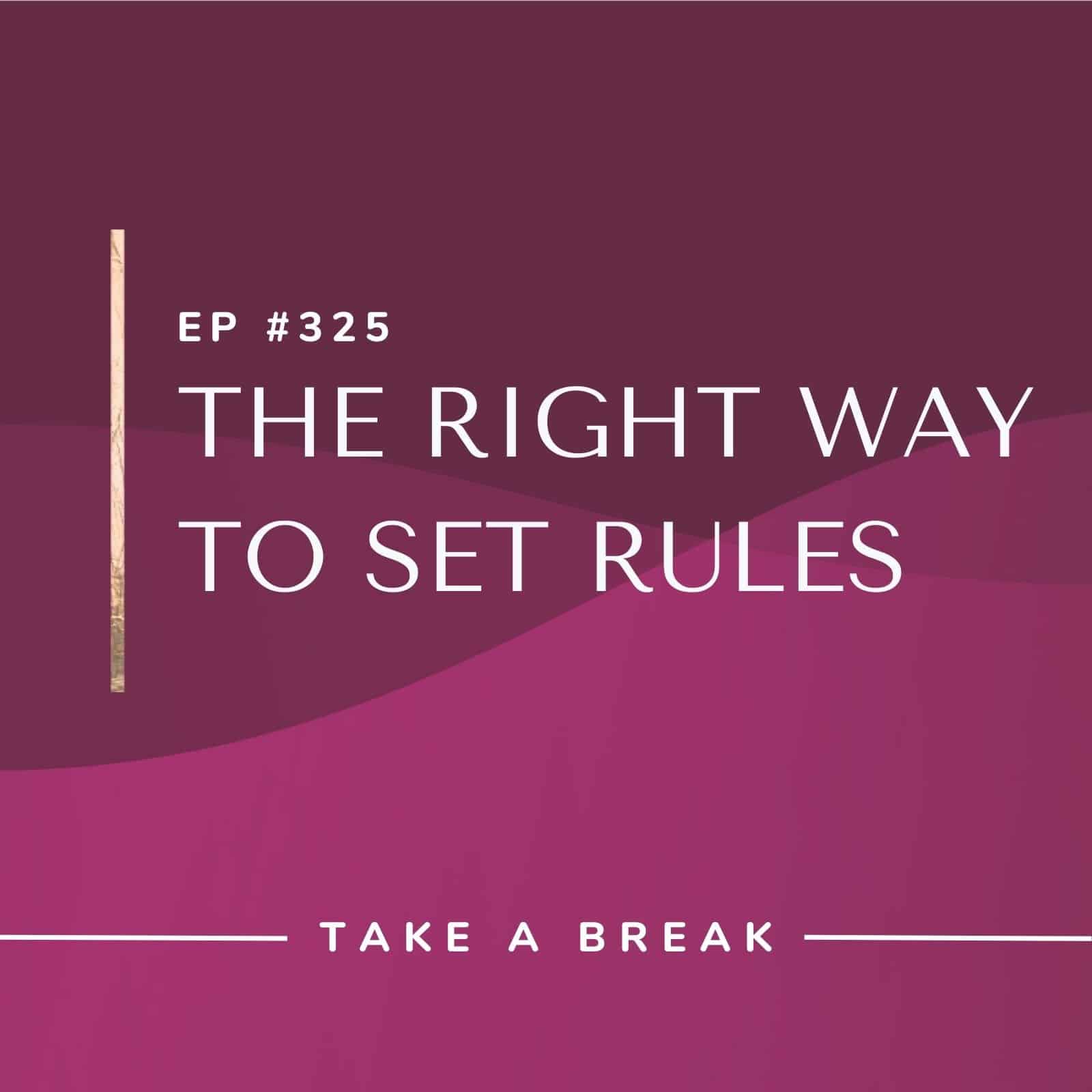The Podcast
Take a Break

Episode #325
The Right Way to Set Rules
subscribe & never miss
Tuesday’s Episode

The rules you have established for when you’re out on the town may be slipping because you have not accounted for your brain’s emotions and expectations.
Rather than piling on the “shoulds” and doubling down on your discipline, look at how you have prepared emotionally for times of craving and desire.
In this episode, learn how to respond to your inner dialogue and your urges with clarity that ignites insight.
What You’ll Discover

Methods of communication to employ when you have an urge.

How to unpack your excuses to learn about your relationship to drinking.

Why rules will only work as well as you have prepared for following them.
Featured on the show
Transcript
You are listening to the Take A Break podcast with Rachel Hart, Episode 325.
Whether you want to drink less or stop drinking, this podcast will help you change the habit from the inside out. We’re challenging conventional wisdom about why people drink and why it can be hard to resist temptation. No labels, no judgment, just practical tools to take control of your desire and stop worrying about your drinking. Now, here’s your host, Rachel Hart.
We are talking about rules today, alright? Rules. Rules around drinking. It’s not something that I talk about a lot on the podcast, because one of my fundamental beliefs is that making rules around your drinking is part of the problem. But I do want to talk to you about them today, because I do think that there is a right way to do it.
Most people who come to this work before they ever find the podcast, before they ever find my book, before they ever join the membership, they have set many rules for themselves around drinking. I certainly did; I set a ton of rules for myself.
I would make rules about how much, how much in a sitting. I would make rules about spacing my drinks out; “I’ll have a beer and then I’ll have a water.” I would make rules about pacing myself; trying to make a drink last for a certain amount of time.
I would have rules around who I would drink with. I would have rules about what kind of things I would drink. I would have rules where I would try to pace myself with a friend who I knew drink a lot slower than I did. I would try to limit myself to certain drinks or certain types of alcohol. I mean, I tried all the rules. I really, really did.
And one of the things that I was missing from this, the piece of it that I didn’t understand for the longest time, I kept telling myself and I kept believing that I was trying new things. Right? Every rule seemed very different to me. Because a rule of just stick to beer versus a rule about spacing drinks out with water, they seemed like two very different things. So, my rules, on the surface, they all seemed very, very different.
But I really was doing the same thing over and over again. I was telling myself, “Listen, Rachel. This is what I want you to do tonight. Tonight, we’re not going to drink. Tonight, we’re only going to have one. Tonight, we’re not going to stop by the wine store. We’re not going to go to the wine bar tonight. We’re not going to overdo it tonight. We’re not going to embarrass ourselves tonight. We are going to make sure that we keep an eye on the clock.” All the things.
I was telling myself what I wanted to do, and giving myself zero instruction for how to do it. I want you to really think about that. How many rules have you set for yourself around your drinking? And how much instruction have you given yourself for how to follow the rule?
This might break your brain a little bit because it’s like, “What do you mean how to follow the rule? I should just follow the rule. I know that I don’t like the results. I know that it’s not whatever, helping how I feel the next day, it’s not helping my weight. It’s not helping my relationships. I should just know how to follow it.”
But I really want you to think about this. How are you going to keep your commitment when your brain is used to doing the opposite? How are you going to say no to your excuses and your urge when your brain is used to giving in? Think about that for a second. So often, when I work with people on this, and what I discovered in myself as well, is that I really only had two tactics.
Tactic number one was discipline, right? Be very strict with myself, say no. Isn’t that what we’re taught? “Just say no. Say no, Rachel. Just be the disciplinarian with myself.” And then, tactic number two was, “I mean, haven’t you just learned your lesson by now? Don’t we have enough evidence? Haven’t we done this enough times to know that this is not a good idea?”
I was swimming in discipline, and shoulds. I had a lot of beliefs that I should be able to discipline myself, I should be able to enforce the rule by saying, “No, no, you can’t have a drink. You can’t have another. You are not allowed. Don’t go there, don’t drink with those people. Don’t go to the store. Don’t go to that party.”
So, I had discipline on the one hand, and then on the other hand, you had all my shoulds. Some of it was, “I should know better. I should have learned my lesson.” But I also had shoulds like, “I should just be able to say no. I should be able to rein myself in. Look at these other people over here, look at these examples that I have, they’re able to do it. I should be able to do this, too. It’s not hard for them, it shouldn’t be hard for me. I know, it’s not good for my health, so I should know better. I have so much evidence that I hate how I feel the next day, so I should stop doing this.”
The problem with these two tactics… And I will tell you this, I mean, I relied on these tactics unknowingly. I didn’t really have awareness of what I was doing at the time. I didn’t understand what was happening beneath the surface. But I’ve relied on these tactics for well over a decade.
The problem that I kept running into is these tactics were sometimes successful, and sometimes not. It so confusing for me. I didn’t understand that shoulds and discipline, these two approaches, they were always going to be hit-or-miss. Because they weren’t teaching my brain anything new. They weren’t giving my brain a new way to respond to urges and excuses.
They weren’t taking into account my emotional experience of the day, or my emotional experience of being at the party, or going out on a date with someone. None of that was factored in. And so, on the one hand, I was like, “Well, okay, sometimes it works. Sometimes I’m good, right? Why can’t it just be all the time?”
And so, I just kept setting new rules and new variations. And again, telling myself, “No, no, you can’t. You can’t have a drink. You can’t have more. You’re not allowed.” And then going back to all of these shoulds. But I had no idea that I was just literally repeating the same process over and over and over again.
The piece that I really want all of you to think about, especially those of you who have tried setting a lot of rules; maybe you’re in the midst of a rule right now. What I want you to think about is okay, so how am I going to follow the rule?
Now, the how is where the think-feel-act cycle comes in. This is why it’s so important. When that urge appears, when that excuse appears, if we’re not going to go right to that place of no, and right into the role of the disciplinarian, well, then what are we going to do?
More often than not, especially when I start working with people, they’ll say, “Okay, well, just give me a distraction. How can I distract myself? What do I need to be doing instead?” The moment that we move away from discipline, we think that the next place to go is distraction. But what if the how is truly, how you talk to yourself in that moment, your internal dialogue?
This is something that so many people will say really blows their mind, when they start using some of the tools that I teach and they start seeing how effective it is to simply notice your thoughts about the urge, and then practice thinking something else. To go from the place of, “God, I hate having urges. This is so unfair. It’s going to last all night; it’s never going to go away. I hate my cravings,”
To the place of, “I’m having an urge. Of course, I’m having an urge. My brain learned to expect a reward at the end of the day or when I go to a restaurant or when I’m with this person or I’m at this activity or doing this thing, or when I feel this way. Of course, the urge is here.” Suddenly, they’re not annoyed or surprised by the presence. It’s like, “Yeah, of course I expected you.”
I really want you to think about how you have talked to your own urges. Do you even talk to your urges? For some people it’s like, are you even aware that the urges are there, that the desire is there? What happens when your excuses come in?
I talk about excuses all the time on the podcast. I talk about something called the Rolodex of excuses. This idea that your brain is just going to keep flipping through excuses until it finds one that it will land on. And it’s like, how about this? How about this? How about this? Will this one work? So, we have this unlimited number of excuses.
And a lot of times people come to me, especially when they’re new to the work, and they feel very dejected. They say, “Okay, so I’m doing the work, and I’m trying to intervene with the habit. And I’m watching my mind, and I’m paying attention. I just have so many excuses, Rachel, just so many. It really feels limitless.”
My response to them is always, “That’s okay. Nothing has gone wrong here. That’s not a problem.” Once you notice that your brain wants to do this. Once you notice that Rolodex of excuses in action, the next thing to really ask yourself is: Okay, so what’s the conversation that I’m going to have with this excuse? How can I start to get to know it better? How can I be curious about it?
Curious about the desire on the surface, right? The desire for the drink, and the deeper desire of what I want in the moment, how I want to feel. You can use your excuses as a way to really unpack what your desire is about. And from there, it’s a whole other conversation.
I was coaching someone on this recently, we were talking about how, in the evening, she feels bored. And her response to that boredom is, “Let’s just drink over it. I don’t want to feel bored.” We started unpacking that together, we started looking at that together, and we came to this place of, “I just want to feel satisfied at the end of the day. That’s what I want. I want to feel satisfied.”
And it’s so hard to feel that way, because at the end of the day, her brain just wanted to be in this little spin about how she wasn’t productive enough, and how she could have done more, and how much she didn’t get done. But all of a sudden, when she could start to see that her excuse around ‘I just don’t like feeling bored. It’s just easier to have a drink,’ she used it as a doorway in.
To see not only is the thing that I’m truly desiring satisfaction, which oh, that’s so normal, right? It’s so human. Don’t we all desire that? Don’t we all just want to feel satisfied with ourselves and our lives? Of course, we do. So, we have this very, very normal desire that every single human has. The way that she had been trying to answer it, the way that she had been unknowingly trying to drink over all her thoughts about how dissatisfied she was.
About how she could have been more productive, and she could have done more things. The way she was trying to deal with it was through a drink. Excuses. That Rolodex is not something that you have to be afraid of. Because watching it, it’s like, oh, here’s another avenue in and another avenue in, and another avenue in, if I’m willing to be curious.
So, you really have to move away from this place of ‘okay, I’m going to make a rule. And I’m just going to use discipline or shoulds to follow it’ and start moving into a place of ‘well, what actually am I going to do in the moment? How am I going to prepare for that moment? Without just relying on no, you can’t?’
Again, because so often, when we try that approach, when we try to use discipline, what happens is we end up feeling resentful. We end up wanting to rebel against it. It’s not a very effective tactic, it might work sometimes, but it’s going to be hit-or-miss.
And so, when you think about it, the right way to set rules is to think about the how. If my brain is used to doing something else, if I’m used to giving in, if I’m used to having more, if I’m used to listening to my excuses, if my brain is used to that, if that is a neural pathway that has gotten more repetition, what am I going to do?
How am I going to find a way to respond differently in the moment? How am I going to keep this commitment when my brain is used to doing the opposite? This is why I talk about tools and skill building being so important. But the thing that I really want all of you to take away, all of you today to think about, what has your how been? Has your how, when it comes to following a rule, been about discipline and shoulds?
If so, that’s very, very normal. That’s what most people rely on. But ask yourself, “Maybe I need a different way. Maybe I need a new way of responding. Maybe I need some tools. Maybe I need to talk to myself differently in the moment. Maybe discipline and shoulds work sometimes, but they’re always going to be hit-or-miss. And if I want to create lasting change, then I need to be showing up differently.”
All right, that’s it for today. I will see you next week.
Okay, listen up. Changing your drinking is so much easier than you think. Whether you want to drink less or not at all, you don’t need more rules or willpower. You need a logical framework that helps you understand and, more importantly, change the habit from the inside out.
It starts with my 30-Day Challenge. Besides the obvious health benefits, taking a break from drinking is the fastest way to figure out what’s really behind your desire. This radically different approach helps you succeed by dropping the perfectionism and judgment that blocks change.
Decide what works best for you when it comes to drinking. Discover how to trust yourself and feel truly empowered to take it or leave it. Head on over to www.RachelHart.com/join and start your transformation today.
Enjoy The Show?

Follow the podcast on Apple Podcasts, Google Podcasts, or Spotify.

Leave us a review on Apple Podcasts.

Learn about the eight Drink Archetypes™ and which ones apply to you by taking the free quiz.

